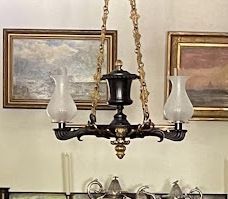Name/Title
Regency Suspended Argand c 1825Description
An Argand lamp is a type of oil lamp that was invented back in 1780. To work, the lamp uses a cylindrical cloth wick inside a close-fitting glass chimney that steadies the air flow both inside and outside the wick. Thick oil is used to soak the wick and then light the same to generate light.
This one is a beautiful patinated and two-tone gilt-lacquered finish distinguishes this lovely suspended argand. The canopy is composed of cast leaves and flowers with a stamped brass collar of beading and tiny tassels. Large elaborately cast chain links are joined to the body of the fixture by snake hooks. A font in the shape of a covered Classical urn rests above the shallow pan with elegant gilt handles and a large two piece gilt finial. Classical masks are centered between the handles.
Curator Notes (Tom Greenwood) It is handmade of forged bronze and brass work. Details include classical motifs related to Freemason symbolism, including small Bacchus masks carefully placed to be viewed while seated at dining table when looking up at chandelier. Captain Watlington advanced as a high-ranking member in Freemason the Key West society/chapter during 1840's and would know the symbols and their meanings. The chimneys and shades are exact replicas of American blown glass from the same historical period for this object. They were designed to amplify as much light as possible. High quality whale oil was best for burning because it did not soot or smoke it burned "clean." Argand lamps/ were used profusely until supplanted by kerosine then gas and finally electric. They predate electric lightbulbs by 75-100 years. Always top of mind and a major part of householding/keeping for the period included fire tending and etiquette.
